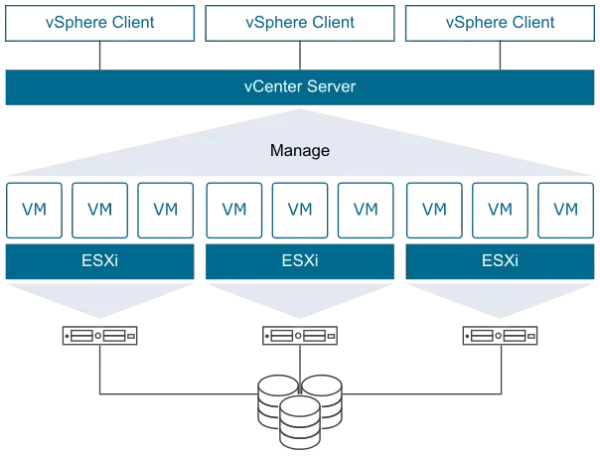Course Description:
This accelerated, hands-on training course is a blend of the VMware vSphere®: Optimize and Scale and VMware vSphere: Troubleshooting courses. This Fast Track course includes topics from each of these advanced courses to equip experienced VMware administrators with the knowledge and skills to effectively optimize and troubleshoot vSphere at an expert level.
Course Objectives
By the end of the course, you should be able to meet the following objectives:
- Introduce troubleshooting principles and procedures
- Use command-line interfaces, log files, and VMware vSphere® Client™ to diagnose and resolve problems in the vSphere environment
- Describe the benefits and capabilities of VMware Skyline
- Explain the purpose of key vSphere log files
- Monitor and analyze key performance indicators for compute, storage, and networking resources for
- VMware ESXi™ hosts
- Optimize the performance in the vSphere environment, including VMware vCenter Server®
- Identify networking problems based on reported symptoms, validate, and troubleshoot the reported
- problem, identify the root cause, and implement the appropriate resolution
- Analyze storage failure scenarios using a logical troubleshooting methodology, identify the root cause, and apply the appropriate resolution to resolve the problem
- Troubleshoot vSphere cluster failure scenarios and analyze possible causes
- Diagnose common VMware vSphere® High Availability problems and provide solutions
- Identify and validate ESXi host and vCenter Server problems, analyze failure scenarios, and select the correct resolution
- Troubleshoot virtual machine problems, including migration problems, snapshot problems, and connection problems
- Troubleshoot performance problems with vSphere components
Certifications
Attendance of this course meets the training requirement to achieve the following certification:
- VMware Certified Professional – Data Center Virtualization (VCP-DCV)
Course Modules
1 Course Introduction
- Introductions and course logistics
- Course objectives
2 Introduction to Troubleshooting
- Define the scope of troubleshooting
- Use a structured approach to solve configuration and operational problems
- Apply a troubleshooting methodology to logically diagnose faults and improve troubleshooting efficiency
3 Troubleshooting Tools
- Use command-line tools (such as ESXCLI) to identify and troubleshoot vSphere problems
- Identify important vSphere log files and interpret the log file contents
- Describe the benefits and capabilities of VMware Skyline
- Explain how VMware Skyline works
- Identify uses for Skyline Advisor
4 Network Optimization
- Explain performance features of network adapters
- Explain the performance features of vSphere networking
- Use esxtop to monitor key network performance metrics
5 Troubleshooting Virtual Networking
- Analyze and resolve standard switch and distributed switch problems
- Analyze virtual machine connectivity problems and fix them
- Examine common management network connectivity problems and restore configurations
6 Storage Optimization
- Describe storage queue types and other factors that affect storage performance
- Discuss vSphere support for NVMe and iSER technologies
- Use esxtop to monitor key storage performance metrics
7 Troubleshooting Storage
- Troubleshoot and resolve storage (iSCSI, NFS, and VMware vSphere® VMFS) connectivity and configuration problems
- Analyze and resolve common VM snapshot problems
- Identify and resolve multipathing-related problems, including common causes of permanent device loss (PDL) and all paths down (APD) event problems
8 CPU Optimization
- Explain the CPU scheduler operation and other features that affect CPU performance
- Explain NUMA and vNUMA support
- Use esxtop to monitor key CPU performance metrics
9 Memory Optimization
- Explain ballooning, memory compression, transparent page sharing, and host-swapping techniques for memory reclamation when memory is overcommitted
- Use esxtop to monitor key memory performance metrics
10 Troubleshooting vSphere Clusters
- Identify and recover from problems related to vSphere HA
- Analyze and resolve VMware vSphere® vMotion® configuration and operational problems
- Analyze and resolve common VMware vSphere® Distributed Resource Scheduler™ problems
11 Troubleshooting Virtual Machines
- Identify, analyze, and solve virtual machine snapshot problems
- Troubleshoot virtual machine power-on problems
- Identify possible causes and troubleshoot virtual machine connection-state problems
- Diagnose and recover from VMware Tools™ installation failures
12 vCenter Server Performance Optimization
- Describe the factors that influence vCenter Server performance
- Use VMware vCenter® Server Appliance™ tools to monitor resource use
13 Troubleshooting vCenter Server and ESXi
- Analyze and fix problems with vCenter Server services
- Diagnose and troubleshoot vCenter Server database problems
- Examine ESXi host and vCenter Server failure scenarios and resolve the problems
Prerequisites
This course requires completion of one of the following prerequisites:
- VMware vSphere: Install, Configure, Manage [V7]
- Equivalent knowledge and administration experience with ESXi and vCenter Server
Experience in working at the command prompt is highly recommended.
Inclusions
With CCS Learning Academy, you’ll receive:
- Certified Instructor-led training
- Official Training Seminar Student Handbook
- Collaboration with classmates (not currently available for self-paced course)
- Real-world learning activities and scenarios
- Exam scheduling support*
- Enjoy job placement assistance for the first 12 months after course completion.
- This course is eligible for CCS Learning Academy’s Learn and Earn Program: get a tuition fee refund of up to 50% if you are placed in a job through CCS Global Tech’s Placement Division*
- Government and Private pricing available.*
*For more details call: 858-208-4141 or email: training@ccslearningacademy.com; sales@ccslearningacademy.com






